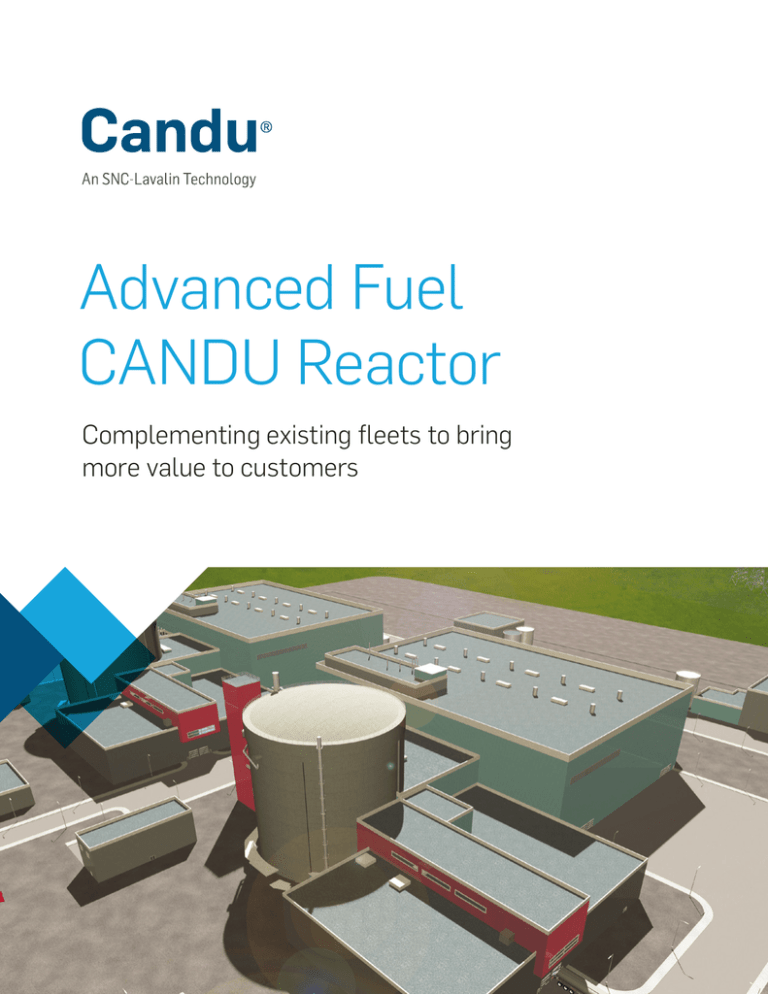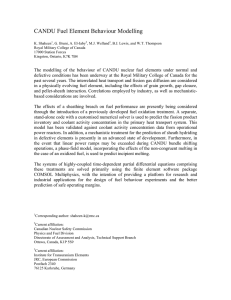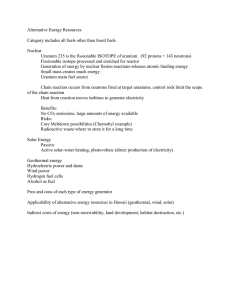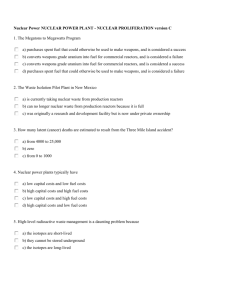Advanced Fuel CANDU Reactor
advertisement

Advanced Fuel CANDU Reactor Complementing existing fleets to bring more value to customers Storage Depleted Uranium Enriched Uranium Recovered Uranium Actinides Thorium Cycle Spent Fuel LWR NUE Enrichment Natural Uranium Thorium Mine + Fissile Low Enriched Uranium Plutonium Reprocessing Recycled Uranium CANDU Depleted Uranium MOX Uranium Mine Storage U-233 + Heavy Element Natural Uranium The SNC-Lavalin Solution With more than a century of experience in the power sector, and over 60 years invested in the nuclear industry, SNC-Lavalin develops nuclear projects tailored to our clients’ needs. Safety, quality, innovation and excellence in project execution are the values we live every day. Our nuclear team brings its expertise to both the light water and heavy water reactor markets. We strive to “think like an operator” to provide innovative and proven solutions to issues before they arise. Reprocessing Advanced Fuels Built on the proven success of CANDU® nuclear technology, and including the most recent advances, the Advanced Fuel CANDU Reactor (AFCR™) is part of our family of Generation III 700 MWe class nuclear power plants, with an evolutionary innovation: the ability to use advanced fuels. The AFCR is our fuel-flexible adaptation of the Enhanced CANDU 6® (EC6®) reactor, and builds on decades of CANDU 6® reactor success. Both incorporate a large number of design enhancements related to safety, fuel flexibility, operational feedback, and lessons learned from events at Fukushima, while achieving high performance goals and economic competitiveness consistent with customer expectations. AFCR Generation III enhancements include: >> Extended plant life of 60 years >> Increased operating and safety margins >> Advanced fuel design >> Robust design against internal and external events >> Inherent accident resistance >> Enhanced passive and active safety features for extended station blackout >> Enhanced core damage prevention features and severe accident mitigation by active and passive provisions >> Advanced fire protection system Proven Success With our Chinese partners, we have already proven, through an in-core irradiation demonstration in the Qinshan CANDU 6 reactors, that recycled uranium (RU) and depleted uranium (DU) can be used successfully as natural uranium equivalent (NUE) fuel. A full core commercial design project is complete and full core conversion to NUE fuel in the existing Qinshan CANDU reactors is planned for 2015, following the licensing process. The AFCR offers you a cost-effective solution in the short term to fulfill intermediate and long-term aspirations for sustainable fuel supply, without major investment or technological risk. Fuel Flexibility A Tradition of Continuous Innovation We designed the AFCR , with fuel flexibility at its very heart. We optimized the proven “classic” CANDU core through very few design enhancements to operate using RU and thorium fuel. Both of these fuel types use our patented CANFLEX® fuel bundle for enhanced reactor performance and increased operating margin. In cooperation with our partners, our work on advanced fuels has led to more advanced, efficient and synergistic fuel cycle options to provide even greater resource utilization advantages to our customers. A Generation III reactor, the AFCR is optimized for alternative fuels with evolutionary, state-of-the-art design improvements built into the EC6. The EC6 successfully completed the final stage of the Canadian Nuclear Safety Commission (CNSC) pre-project design review in June 2013 and is now ready for site-specific application. The AFCR offers you a cost-effective solution in the short term to fulfill intermediate and long-term aspirations for sustainable fuel supply, without major investment or technological risk. The successful introduction of NUE fuel in the CANDU reactors in Qinshan, China, has proven the ability of CANDU reactor technology to adopt alternative fuels. Direct use of recycled uranium (DRU), NUE and low enriched uranium/ thorium can all significantly reduce reliance on natural uranium for nuclear power generation as well as introduce new fuel resources into the cycle. Capitalizing on a strong synergistic relationship, RU from light water reactor (LWR) fleets can be used without re-enrichment in CANDU reactors. One AFCR can operate on the RU from four LWRs. The AFCR advances the continuous evolution of the EC6 design, incorporating fuel-related advantages while retaining the proven excellence of the CANDU 6 reference plant. The AFCR preserves many essential features of the proven CANDU design, including: >> Horizontal fuel channel design >> On-power refuelling >> Fuel design that is simple, easy to handle and easy to manufacture >> Low-pressure and separate heavy water moderator >> Water-filled reactor vault >> Active and passive core cooling capability >> Two independent, diverse, fast-acting shutdown systems >> Unique inherent emergency-cooling capability >> Accessible reactor building for on-power maintenance Compatible with Existing Fleets The AFCR efficiently uses RU from the spent fuel of LWRs. This ability contributes to the sustainable and large scale development of nuclear power, while avoiding the complexity and associated cost of recycling RU for LWRs. Using RU in CANDU reactors improves the uranium resource utilization and also results in fuel cost savings for the utility. The AFCR is designed for a CAPACITY FACTOR OF 90% 60-YEAR for a PLANT LIFE Advanced Safety Features The AFCR maintains traditional inherent safety design features of CANDU reactors, which have safely operated for decades around the world, and incorporates further safety enhancements to meet the latest safety standards and postFukushima requirements. In addition, its core design features advanced fuel-related safety enhancements. All reasonably practicable design measures have been taken into account to prevent accidents and to mitigate their consequences. New passive and active design features aim to practically eliminate plant states that could lead to early or large radioactive releases. The AFCR safety features include: >> Long prompt-neutron lifetime >> Low power density >> Two-group design to ensure two independent means to achieve same safety functions >> Reactivity devices in cool, low-pressure moderator without possibility of rod ejection >> Effective Heat Transport System (HTS) thermosyphoning Expert Panel Review of AFCR In 2014, a Chinese Expert Panel reviewed the technology and concluded “the AFCR development is based upon a proven technology and has adopted an evolutionary approach. The design meets the latest nuclear safety requirements and the requirements for a Generation III nuclear power technology and has achieved a good balance of advancement and maturity. AFCR is technically feasible and possesses good safety.” The panel recommended that China “initiate the construction of AFCR to unlock and utilize its various advantages.” for core cooling for loss of forced flow >> Slow accident progression without high pressure core melting >> Large inventory of water inside containment for core cooling >> Dedicated active and passive severe accident prevention and mitigation systems >> Passive and active measures to prevent core damage >> Passive cooling for In-Vessel Retention (IVR) >> Passive and active provisions for hydrogen control >> Passive and active containment heat removal >> Provisions to preclude uncontrolled releases The principles of separation, diversity and high reliability apply to the design of the safety systems that perform AFCR safety functions, including shutdown systems, the emergency core cooling system and containment systems. The enhanced emergency water supply (EWS) system provides both passive and active make-up to the steam generators. The decay heat can be effectively removed from the core by the EWS for more than 72 hours. CANDU reactor design has inherent safety features which act as defence mechanisms against severe accidents. A cool and low-pressure moderator provides a passive heat sink to absorb decay heat from the fuel for postulated conditions of beyond design basis accidents (BDBAs). A large volume of water contained in the calandria vault that surrounds the reactor core provides the second passive heat sink for the core and can further slow down or arrest severe core damage progression. Designed with our Customers in Mind The AFCR also provides a dedicated severe accident recovery and heat removal system to minimize the risks of severe accidents. This system, which includes gravity-driven, passive water supply lines and a pump-driven recovery circuit, is designed to arrest and contain any severe core damage within the calandria vessel and ensure that the containment integrity is maintained following BDBAs. The AFCR containment design provides both active and passive measures to maintain containment integrity. A passive containment heat removal system (PCHRS) removes heat from the containment by natural circulation with no operator intervention for 72 hours. AFCR containment and the spent fuel bay are designed to protect against large aircraft crash. Spent fuel cooling can be maintained for 15 days without dependency on operator action in a station blackout. Clean Energy For security and physical protection, the AFCR ensures required response to potential common mode events, such as fires, aircraft crashes and design basis threats. 26 25 24 5 2 4 6 7 11 Every twin reactor AFCR nuclear power plant can generate enough power to meet the daily needs of up to 2 million people with no emissions of nitrogen oxide, sulphur oxide, toxic heavy metals, aerosols, ozone or other pollutants. Each twin reactor AFCR saves: >> Up to 13 million tonnes of carbon dioxide (CO2) emissions per year, when displacing traditional coal >> Up to 6 million tonnes of CO2 emissions per year, when displacing natural gas Track Record of International Success The last seven CANDU plants have been built on or ahead of time and on budget—the best track record of any nuclear vendor in the world. We are backed by a strong Canadian and international supply chain that has helped deliver CANDU reactors to customers around the world. AFCR Cutaway Key 1.Reactor Building 11.Pressurizer 2.Dousing Tank 12.Local Air Cooler 3.Dousing System Supply Pipe 13.Main Crane 4.Dousing System 15 14 9 16 23 12 13 8 1 10 3 The AFCR incorporates strong operational utility experience from the China National Nuclear Corporation (CNNC) CANDU reactors in Qinshan. CANDU reactors use a unique reactor technology designed to allow for on-power refuelling and online maintenance. Utilities in Canada, Asia, Europe and South America count on CANDU technology for higher lifetime capacity factors than competing technologies. 19 17 21 18 20 22 14.Reactivity Mechanism Deck 5.Calandria Vault Make-up Tank 15.Boiler Enclosure 6.Walkaway 17.Feeder Pipes 7.Main Steam Line 8.Steam Generator 9.Heat Transport Pipe 10.Main Feed Water Line 16.Headers 18.Calandria 19.Helium Supply Tank 20.Gadolinium Pressure Vessel Liquid Injection System 21.Fuelling Machine Bridge & Carriage 22.Spent Fuel Handling Mechanism 23.Severe Accident Recovery & Heat Removal System 24.Passive Containment Heat Removal System (PCHRS) Loop 25.PCHRS Storage Tanks 26.PCHRS Vented Enclosure NUCLEAR OFFICE 2285 Speakman Drive Mississauga, ON, L5K 1B1, Canada Telephone: +1 905 823 9040 Email: nuclear@snclavalin.com www.snclavalin.com/nuclear PRINTED IN CANADA 201_2015-04 ® Registered trademark of Atomic Energy of Canada Ltd. (AECL), used under licence by Candu Energy Inc., a Member of the SNC-Lavalin Group. ™ Trademark of Candu Energy Inc., a Member of the SNC-Lavalin Group.






